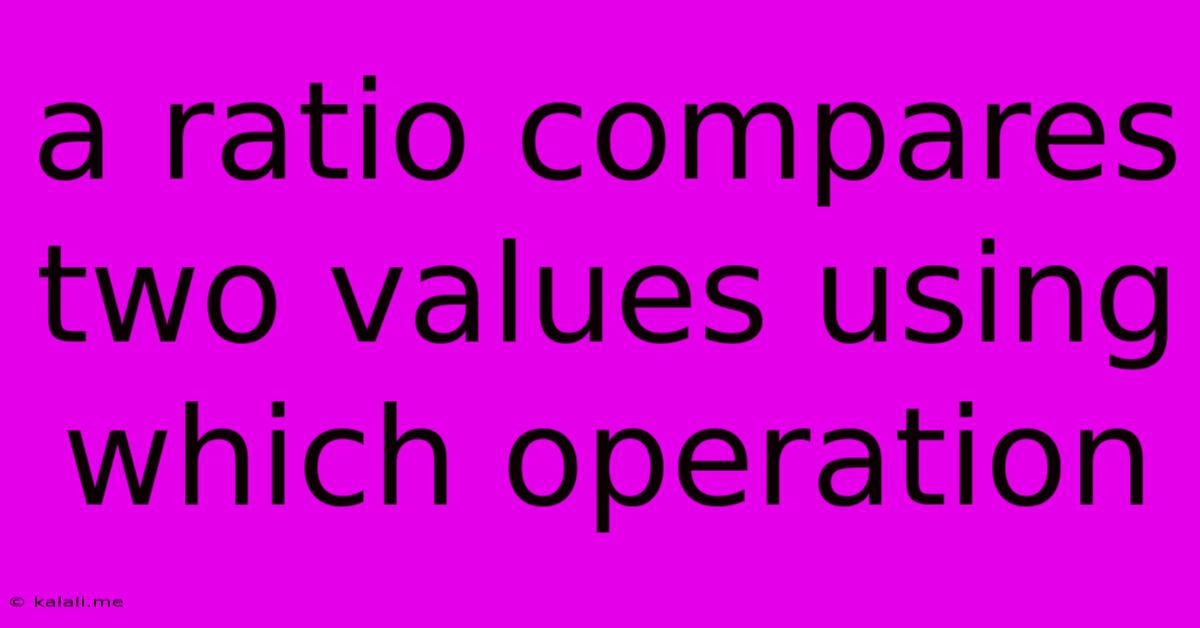A Ratio Compares Two Values Using Which Operation
Kalali
Jun 16, 2025 · 3 min read

Table of Contents
A Ratio Compares Two Values Using Division: Understanding Ratios and Their Applications
Meta Description: Learn how ratios compare two values using division. This article explores the fundamentals of ratios, their applications in various fields, and how to interpret and use them effectively. We'll cover simplifying ratios, equivalent ratios, and real-world examples.
Ratios are a fundamental concept in mathematics and have wide-ranging applications in various fields. At its core, a ratio compares two or more quantities using division. It shows the relative sizes of the quantities. While ratios can be expressed in several ways (using the colon ":", the word "to", or as a fraction), the underlying operation is always division.
Understanding the Division in Ratios
Let's consider a simple example: Suppose you have 3 apples and 5 oranges. The ratio of apples to oranges is 3:5, which can also be written as 3/5. This represents the division of the number of apples (3) by the number of oranges (5). The result (0.6 in this case) tells us that for every 5 oranges, there are 0.6 apples, or proportionally, there are fewer apples than oranges.
This division aspect is crucial. It allows us to make comparisons and understand the proportional relationships between different quantities. It's not merely a listing of two numbers; it's a statement of their quantitative relationship through division.
Different Ways to Express Ratios
As mentioned earlier, ratios can be expressed in several forms:
- Colon notation: 3:5 (apples to oranges)
- Fraction notation: 3/5 (apples to oranges)
- "To" notation: 3 to 5 (apples to oranges)
No matter the notation, the core mathematical operation remains division. The choice of notation often depends on the context and personal preference, but the underlying meaning is consistent.
Simplifying Ratios and Equivalent Ratios
Often, ratios can be simplified just like fractions. For instance, a ratio of 6:12 is equivalent to 1:2 because both numbers are divisible by 6. This simplification doesn't alter the relative relationship between the two quantities; it merely presents the ratio in a simpler, more manageable form.
Finding equivalent ratios involves multiplying or dividing both parts of the ratio by the same non-zero number. This maintains the proportional relationship between the quantities.
Applications of Ratios in Real Life
Ratios are ubiquitous in everyday life and are used extensively in various fields:
- Cooking: Recipes often use ratios to specify ingredient proportions (e.g., a 1:2 ratio of sugar to flour).
- Scale Models: Architects and model makers use ratios to create scaled-down representations of buildings or objects.
- Finance: Ratios are fundamental in financial analysis, helping investors evaluate company performance (e.g., debt-to-equity ratio, price-to-earnings ratio).
- Science: Ratios are used extensively in scientific calculations and experiments.
- Mapping: Maps use ratios (scales) to represent distances accurately.
Conclusion
In conclusion, a ratio fundamentally compares two values using the operation of division. Understanding this core principle is key to grasping the concept of ratios and their extensive applications in various aspects of life. From everyday tasks like cooking to complex calculations in finance and science, ratios provide a powerful tool for understanding and analyzing proportional relationships between quantities. By mastering the concept of ratios, including simplification and the identification of equivalent ratios, one gains a valuable skill with wide applicability.
Latest Posts
Latest Posts
-
How To Create Clickable Image In Html
Jun 16, 2025
-
What Are The Factors Of 121
Jun 16, 2025
-
What Is A Theme Of The Passage
Jun 16, 2025
-
A Company That Provides Access To The Internet
Jun 16, 2025
-
Which Word Is Closest In Meaning To The Underlined Word
Jun 16, 2025
Related Post
Thank you for visiting our website which covers about A Ratio Compares Two Values Using Which Operation . We hope the information provided has been useful to you. Feel free to contact us if you have any questions or need further assistance. See you next time and don't miss to bookmark.